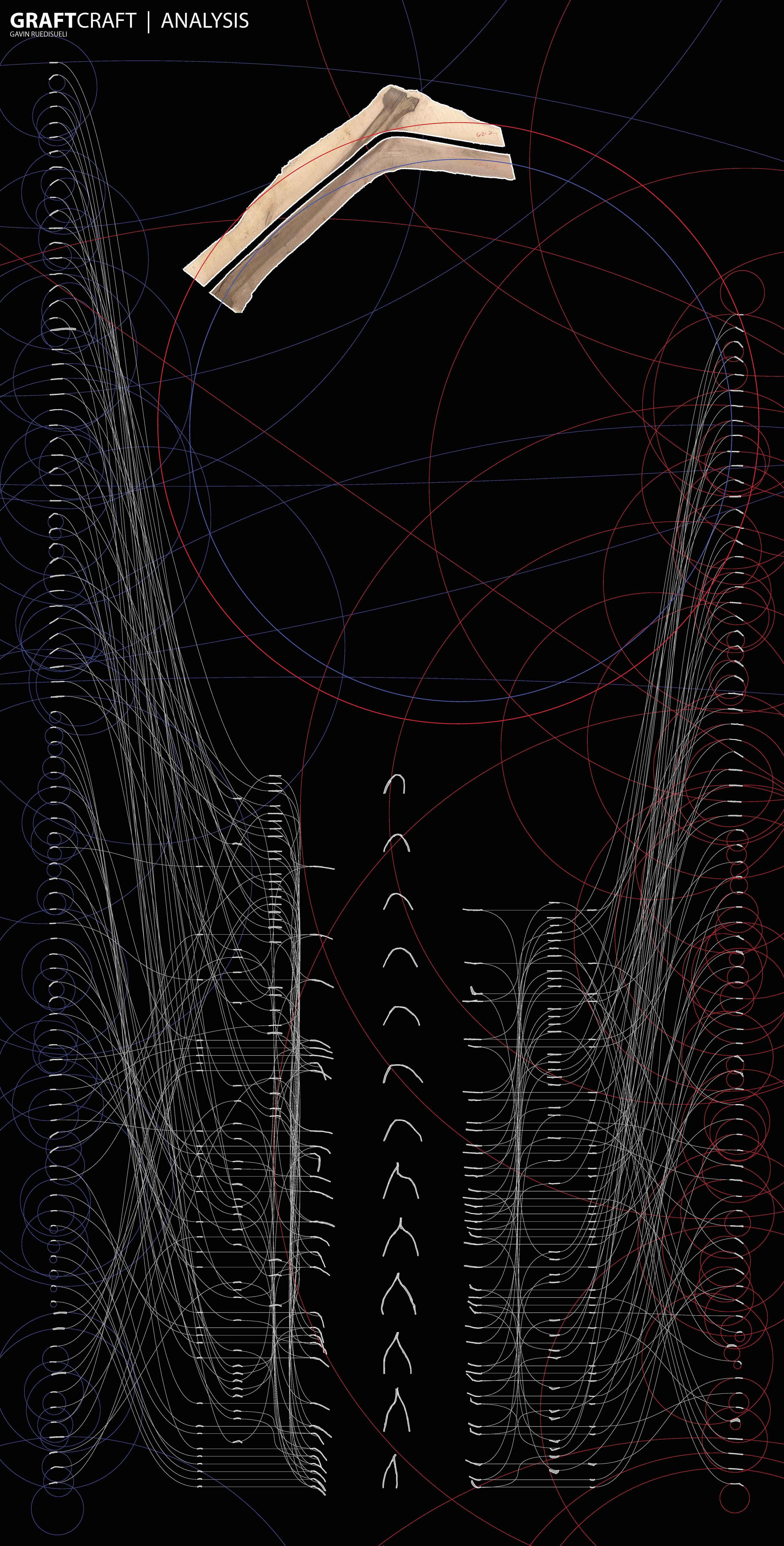Wood Urbanism Studio
Professors: Jane Hutton and Kiel Moe
Program: M.Arch I: Harvard Graduate School of Design
Site: secondary forests in central Chile
Team: Gavin Ruedisueli
Key Terms:
Form: physical manifestation that which is derived from a process, including natural processes such as volcanism
Shape: abstract geometrical relationships, such as spheres, domes, rectangles, and infinite straight lines.
Abstract:
Through an immanent model of understanding of the world, coupled with digital feedback tools, our design techniques can more directly respond to contextual conditions and enhance our relationship with the world.
Architectural design, at least partially understood in western culture as imposing shapes on material, can be inverted, to using the material to drive a form. By engaging craftspeople as speakers for their zone of expertise, architects can expand their own agency through a parallel granting of creative latitude to craftspeople. Furthermore, through tools that allow for mass variation of objects, we can reinject craft into contemporary construction techniques.
All wood is curved. Within the context of western industrialized economies, processing seeks to make curves straight and through this incurs costs, many of which are considered externalities. These costs include wasted material, increased carbon emissions, and added cost of material for the consumer. We seek to find a way for property owners to thin the forests on their own land and the wood in the form that it has grown into. Through this process, we reduce processing costs as well as derive architectural form from the trees themselves, rather than imposing form on naturally heterogeneous materials.
Furthermore, by creating simpler production chains, we can empower those who are building their own structures, such as small landowners and farmers. We can provide tools to unleash the creativity of individuals as well as teach them about how to craft their own structures and how to work with wood.
In Chile, we face a culture that is re-learning how to work with wood. After all, the Mapuche people practiced wood construction for generations before the arrival of European colonies. Currently it is difficult to use wood. In addition to cultural aversions and lack of knowledge about wood construction, wood is difficult to harvest and transport over the kilometers of rough roads that crisscross the Chilean countryside. How can we create tools that allow someone with limited woodworking skills take advantage of this abundant material?
In the industrialized world, homogeneity has become a primary goal of the industries that produce building materials. Materials that were in former times understood to be inherently heterogeneous have been placed into broad categories that ignore the intricacies of a material’s grain. This insistence on a homogenous product tends to lead to massive piles of waste (“aberrant”) material that is not desirable for one reason or another. Sometimes this can be sold to craftspeople, but usually it is burned or turned into paper. A craftsperson understands how to look at wood grain and modify their design to the building materials at hand.
This state of affairs is partially the result of economics (which are culturally bound, there is nothing inherent about material/labor that relates to how we value it), which while varying throughout the world, in the western context have favored production techniques with lower amounts of labor while relying on cheap materials. After all, to cut each wood custom is understood to be labor-intensive and expensive. However, modern scanning technologies such as industrial CT scanners already used in timber factories allow for a high-tech processing of each piece of lumber such that each knot and curve can be understood. Except for a few companies, these are geared towards the production of straight lumber, however.
In the case of Chile, we are not looking to industrialize a process, however, because we cannot expect a few landowners to be able to invest in an entire factory. What we need is a cheap method of scanning, which is possible through the cell phone and laptop. We can take a series of images of wood and then run these photos through an algorithm that lays out the curved pieces.
I draw on the precedent of the “cruck” frame, which is seen in different variations around the world and utilizes curved pieces, which can be found locally, to approximate the shape of a structure. There is an understanding that the form of the building is derived from the specificities of each forest.
The Farmer:
The farmer must consider what logs are available. Walking through the forest, trees are selected for culling. They may be culled for any number of reasons but the end result is a heterogeneous stock of wood. Before felling the trees, the farmer takes photographs with a smartphone of each side of the tree. These images will be then fed into user-friendly software (such as Autodesk Remake) that can stitch the images together into a 3d model. This 3d model can be analyzed, and the skeleton of the tree derived. This skeleton will tell the farmer where inflection points in curves occur in the trunk, and thus where to cut the trunk in order to create a set of flat curved logs (as opposed to logs that curve in more than two dimensions). Using this set of information, the farmer can then study the available stock and begin to get a rough idea of what type of structure can be built with this material. Is it a long span structure? Do there need to be a lot of splice joints or can he or she use longer sections of wood?
Armed with this information and a rough design, the farmer harvests the selected trees and drags them to a portable lumber mill with a tractor and a chain. The farmer is able to slice each log in half with a bandsaw. Once all the logs have been sliced in the center, an array of curved pieces can be laid out in a field, and photos captured of each log. These photos can be then fed into a computer algorithm that analyzes each piece for its approximate curvature and length. The algorithm can organize these pieces into tables showing categories of branch types. It can even begin to set up rudimentary arrays of pieces along predefined trajectories that approximate the design intent. A push and pull between the design and available material ensues, where different iterations of logs gradually bring the structure closer to the idealized goal, yet never reaching it.
The logs can be sliced into thinner timbers that are curved and which are light enough for a few workers to lift into place without the need for heavy machinery that would be costly to buy or rent. After drying for a period of years, these smaller pieces can be spliced together by using scarf joints in combination with metal straps that compress the two pieces into cohesive splice joints that act as one continuous beam. Once the structural skeleton is in place, further lateral support via roof slats can be added. These slats can be made of thin stocks of straight wood, bent over the roof rafters. Following the roof slats, the building can be weatherproofed with shake shingles or thatching. Shake shingles are easy for the farmer to manufacture on site because they are simply split by hand from short logs about the size of a piece of firewood and easy to manage by one person. Thatching is another alternative that offers a benefit of substantial thermal separation from the elements, removing the need of the farmer to find other materials that would be costly or carry a heavy environmental footprint.



































































































































































